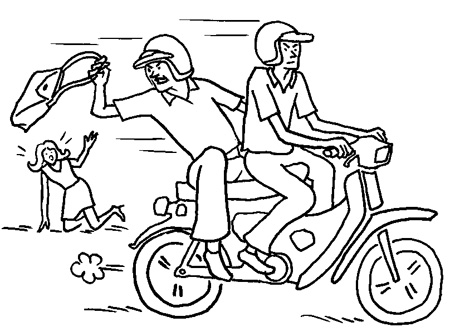Difference between revisions of "Security issue: Robbery"
| Line 15: | Line 15: | ||
Several subtypes of street robbery exist that vary in frequency depending on local circumstances. Among the better known are: |
Several subtypes of street robbery exist that vary in frequency depending on local circumstances. Among the better known are: |
||
* purse-snatching (referred to as "snatch theft");[[Image:SnatchThieves003.jpg|thumb|right|300px|Snatch theft, |
* purse-snatching (referred to as "snatch theft");[[Image:SnatchThieves003.jpg|thumb|right|300px|Snatch theft, depicted here as done from a motor vehicle]] |
||
* robbery at automated teller machines; |
* robbery at automated teller machines; |
||
* robbery of drunken bar patrons; robbery of students (e.g., middle- and high-school students and college students); |
* robbery of drunken bar patrons; robbery of students (e.g., middle- and high-school students and college students); |
||
Revision as of 12:01, 15 August 2012
Contents
Security issue: Robbery
Robbery is the crime of taking or attempting to take something of value by force or threat of force or by putting the victim in fear.
Description
In the context of urban planning, robbery is most relevant if performed in the public space. This form of robbery, called street robbery has the following five characteristics[1]:
- the offender targets a victim;
- the victim is a stranger to the offender;
- the offender attempts or completes a theft of cash or property;
- the offender uses force or the threat of force against the victim; and
- the offense occurs in a public or semipublic place, such as on a street, in an alley, in a parking garage, in a public park, on or near public transportation, or in a shared apartment hallway.
Mark that a robbery need not involve the use of a weapon or injuries of the victim.
Several subtypes of street robbery exist that vary in frequency depending on local circumstances. Among the better known are:
- purse-snatching (referred to as "snatch theft");
- robbery at automated teller machines;
- robbery of drunken bar patrons; robbery of students (e.g., middle- and high-school students and college students);
- robbery of passengers near public transportation systems; and
- robbery of migrant laborers.
Attributing circumstances
Impacts
Measures
Many strategies exist to reduce the risk of street robbery. Of these, most are actions that are taken just before or after specific incidents. These are therefore not suited to be integrated in to the planning of urban environment, as this generally precedes incidents by a long time. Measures[1] that are effective against street robbery and can be taken (or at least influenced) by the urban planner, are:
- Providing safe transportation
- Providing safe routes during construction
- Reducing intoxication in high-risk areas
- Removing hiding spots
- Increasing lighting at high-risk sites
- Surveillance (electronic or other)
- Increasing pedestrian density near risky places
- Installing emergency call stations
Footnotes and references
MAP
<websiteFrame> website=http://securipedia.eu/cool/index.php?concept=Risk width=100% border=0 scroll=auto align=middle </websiteFrame>
<headertabs/>
